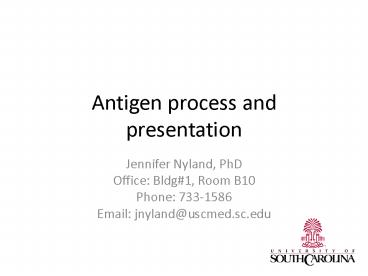Antigen process and presentation - PowerPoint PPT Presentation
1 / 23
Title:
Antigen process and presentation
Description:
Not as effective as DCs in activating na ve Ts. Effective in activating memory Ts ... All Ts with that particular V in their TCR activated ... – PowerPoint PPT presentation
Number of Views:121
Avg rating:3.0/5.0
Title: Antigen process and presentation
1
Antigen process and presentation
- Jennifer Nyland, PhD
- Office Bldg1, Room B10
- Phone 733-1586
- Email jnyland_at_uscmed.sc.edu
2
Teaching objectives
- To compare and contrast Ag recognized by TCR and
BCR - To describe the pathways involved in processing
endogenous and exogenous Ag - To discuss self MHC restriction in Ag
presentation to T cells - To describe the major APCs
- To compare and contrast presentation of
conventional and superAg - To discuss the role of positive and negative
selection in the thymus and generation of self
MHC restricted Ts
3
Comparison of TCR and BCRAg recognition
- BCR
- Soluble or cell associated
- Proteins (conformational and sequence
determinants) - Polysaccharides
- Nucleic acids
- Some lipids
- Some chemicals (haptens)
- TCR
- Only peptides associated with MHC on surface of
APCs - Th recognize in context of MHC class II
- CTL recognize in context of MHC class I
4
Ag processing and presentation
- Ag processing
- Ability of APC to breakdown Ag into peptides and
associate them with MHC - Ag presentation
- Process of displaying peptide Ag in context of
MHC to T cell
5
Ag processing pathways
6
Ag processing pathway- MHC class I
7
Ag processing pathway- MHC class II
8
Important aspects of Ag processing
- Location of pathogen dictates type of response
- Virus in cytosol ? MHC class I pathway ? CTL
- Extracellular pathogen ? MHC class II pathway ?
Th2 response ? Ab production - Intracellular pathogen in cytosol ? MHC class II
pathway ? Th1 response ? cytokine production
(activation of infected cell)
9
Important aspects of Ag processing
- Peptides from both self and non-self proteins can
associate with MHC molecules - Chemical nature of MHC groove determine which
peptides will bind - Anchor sites
10
Self MHC restriction
- T cells recognize Ag in context of MHC
- MHC molecules are polymorphic
- Can T cells recognize Ag in any MHC?
- NO
- Ts are restricted to recognizing the context of
self MHC only
11
Ag presenting cells (APCs)
- Dendritic cells (DCs)
- Macrophages
- B cells
12
APCs dendritic cells
- Found in the skin (Langerhans cells)
- Ingest Ag by pinocytosis
- Pick up Ag in peripheral tissues and migrate to
peripheral immune tissues (LN and spleen) - Most effective APC for activation of naïve Ts
- Can present internalized Ag in context of both
MHC class I and class II (cross presentation)
13
APCs - macrophages
- Ingest Ag by phagocytosis
- Not as effective as DCs in activating naïve Ts
- Effective in activating memory Ts
14
APCs B cells
- Bind Ag by surface Ig
- Ingest Ag by endocytosis
- Not as effective as DCs in activating naïve Ts
- Effective in activating memory Ts
- Very effective APCs when Ag concentrations are low
15
Presentation of superAg
- Superantigens
- Produced by certain pathogens
- Activate Ts polyclonally
- ? cytokine production
- Can have pathological effects
- Not processed by APC
- Presented by APC in association with MHC class II
16
Presentation of superAg
- superAg
- Intact protein binds MHC class II and Vß region
of TCR - All Ts with that particular Vß in their TCR
activated - ? activation of large numbers of Ts and
subsequent cytokine release and pathology
17
Thymic education
18
Thymic education
- How are self MHC-restricted Ts generated?
- Why are self-reacting Ts not produced?
- Random VDJ rearrangements in Ts should generate
some TCRs that can recognize non-self MHC - Random VDJ rearrangement should generate some
TCRs that can recognize self Ag - Thymic education positive and negative selection
19
Thymic education
- Role of the thymus- site of Ts maturation
- Ts with TCR recognizing self MHC are retained
positive selection - Retained Ts with TCR recognizing self Ag in self
MHC are eliminated negative selection - Remaining Ts are self MHC-restricted and will
recognize foreign Ag - Released to periphery
20
Thymic education
21
Thymic education
- Commitment to CD4 or CD8 T depends on MHC class
that is encountered
22
Negative selection in periphery
- Some self reactive Ts may get to the periphery
- Positive and negative selection is not completely
effective - Not all self Ag are expressed in thymus
- Mechanisms to eliminate self-reactive Ts in
periphery - Tolerance (lecture 17)
23
B cell selection
- Does B cell selection occur?
- No need for positive selection
- Bs are not MHC-restricted
- Negative selection does occur in bone marrow
- Not as critical as for Ts































